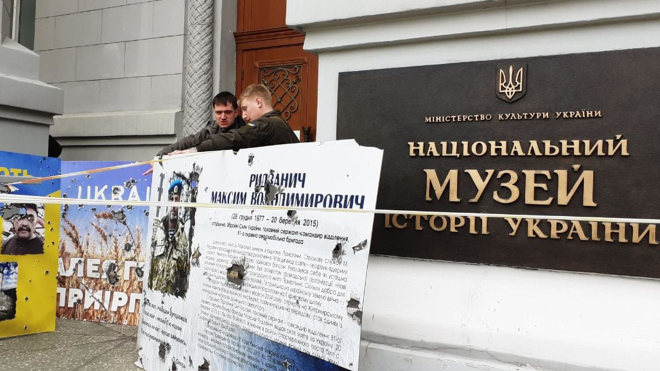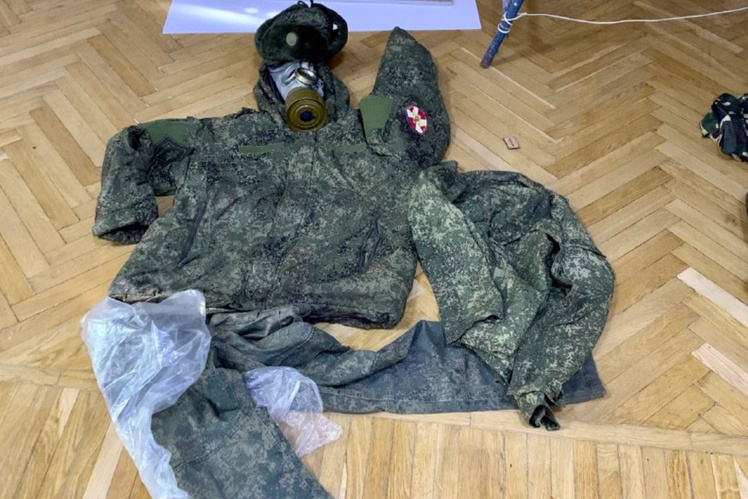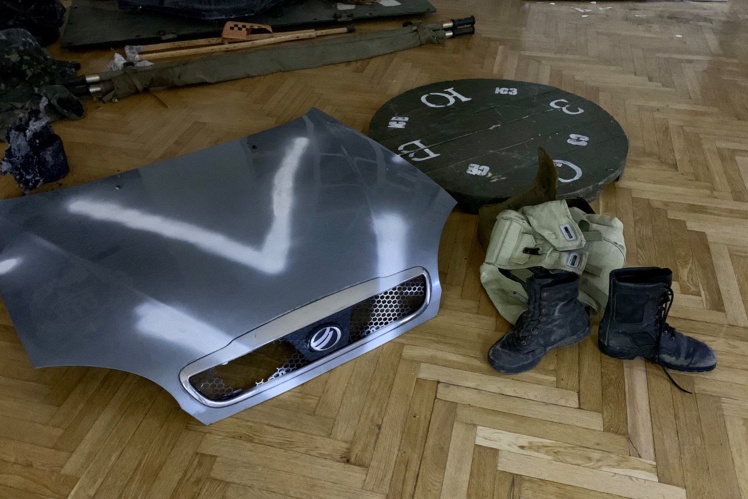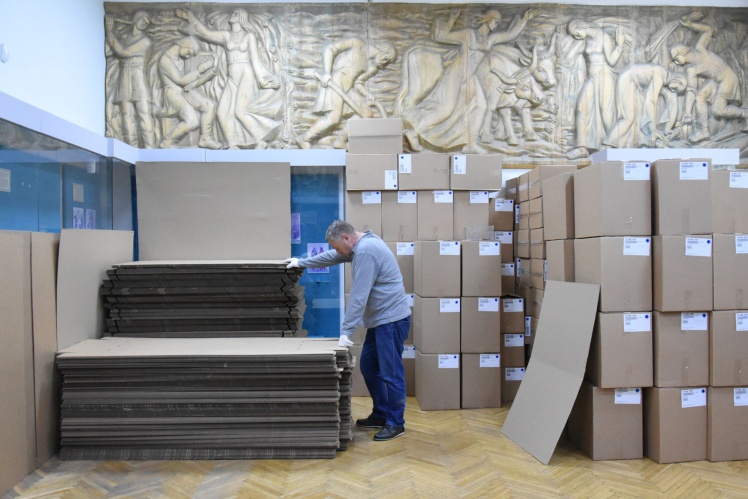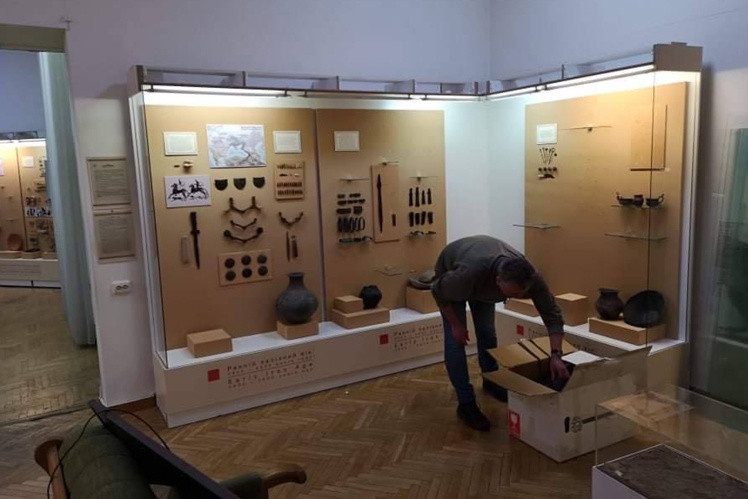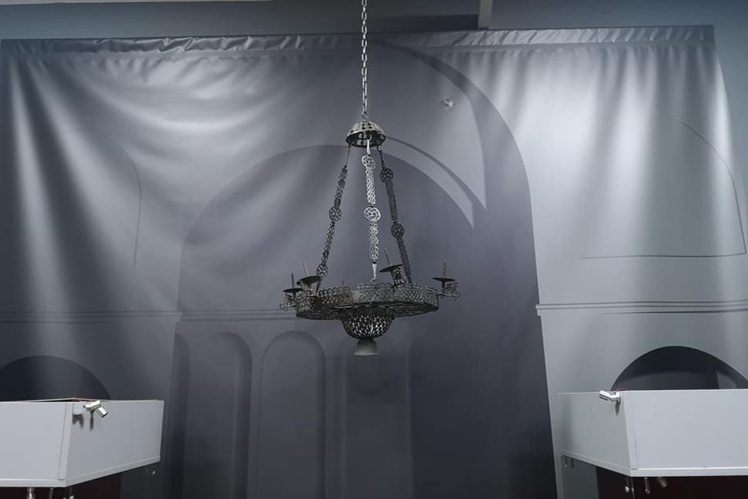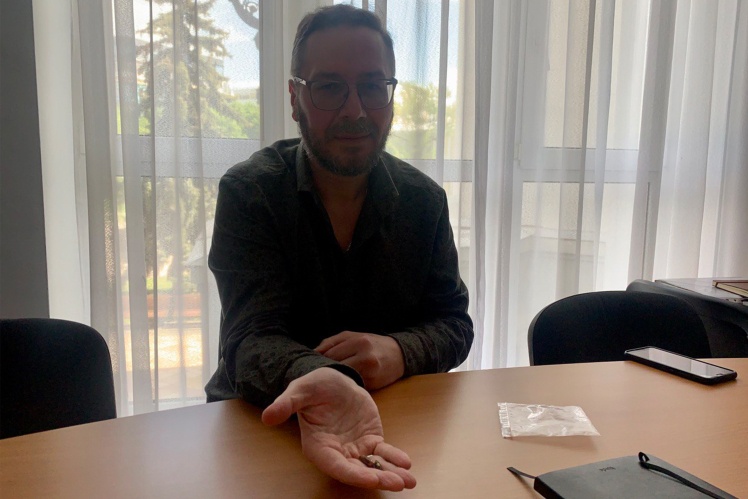Why there are Russian military uniform, ushanka, kirza boots on the floor of the museum lobby?
We have an active group — the Department of History of Independent Ukraine. They documented the pandemic, now the war. When it became more or less calm in Kyiv Oblast, we went on an expedition through the liberated territories — collecting things for the exhibition.
We take what we can. We donʼt expect to pull an armored personnel carrier here but select the most eloquent items. For example, look at the hood of a civilian car with the letter V painted on it. We also want to have a car door punctured by bullets or blown up, the Danish War Museum even ordered such a thing from us, but itʼs difficult. What is more or less well preserved is integrated by the Armed Forces or local population.
National Museum of History of Ukraine / «Babel’»
By integrating you mean they put it into use?
Yes. In general, this isnʼt our specialization, because we are not a museum of war. But we can not ignore these events, as they are a part of the history of Ukraine. Obviously, the war must be integrated into our exhibition.
At the entrance, there is an armed guard in military uniform, which does not allow you to enter without a special invitation. Is the museum closed to visitors?
Yes, starting from February 24 and as long as there is an air raid threat, I donʼt see opportunities for opening. Although the decision on this issue should be made by the Minister [of Culture and Information Policy Oleksandr Tkachenko]. But look at Lviv. It looks like a safe place, but missiles strike there as well. There is no safe place [in Ukraine]. Museums are shelled just like everything else.
On the first day [of the full-scale invasion] we disassembled the exhibition. We undressed the museum, in fact. Everyone thought that the war was somewhere far away, and it happened in the morning and in Kyiv.
What does the museum do without visitors and with a hidden collection?
The public activities are currently impossible, but the museum has work to do. For example, the funds are undergoing restoration work. It is necessary to look at the condition of the exhibits, to carry out continuous check-ups Because, over time, destructive things can happen, as we are dealing with ancient objects.
At the end of last year, we started working with the museumʼs digital database. Roughly speaking, we create a register of the objects we have. We enter everything in the database, it will become partially public.
It should have been done 20 years ago and in a centralized manner, at the state level, but it didnʼt happen. We bought the museum package [of the software] ourselves and are filling it with information. We describe each museum object: what it looks like, where it was found or donated, the history of its origin. We create a passport of each object and add photos.
National Museum of History of Ukraine / «Babel’»
Expositions were disassembled on February 24?
At about half past five in the morning, a colleague called and said that the airports were being bombed. I realized that I heard strange sounds during my sleep.
Obviously, war could have been foreseen, but then it seemed that the situation was escalating in order to bargain for something. Last year, we discussed with colleagues what a plan of action should be in case of military events [in Kyiv]. And we developed it. But it turned out that what we calculated didnʼt work at all. For various reasons. We did not foresee that this would happen in this way — with missile shelling and airstrikes. Also, some people who were supposed to appear in the museum that day did not come. For various reasons, objective and non-objective.
On the morning of the 24th, I still didnʼt understand the scale of the events. I understood only the fact that if there are missile strikes, you need to quickly hide the exhibits. Most of the team came to the museum to save the collection. These were people with different functions — workers, custodians, lawyers, and technical staff. They came despite the explosions, when everyone ran away.
We also have about ten employees who dismantled the collection during the day and went to the military registration and enlistment office in the evening. For example, a young employee dismantled a collection during the day and enlisted in the National Guard in the evening or the next day.
Did you have instructions on how to act in the museum during the shelling?
There is a Soviet instruction with the prescribed procedure: what to do first, what to do next. We were guided by it. On the first day itʼs impossible to disassemble the collection — the museum is huge, so we removed the main objects. We worked until four in the morning of February 25.
I was so focused on what needed to be done in the museum that I didnʼt even answer the phone. People often ask me what I remembered about the first day. I have absolutely no memory of what happened outside the museum. But what happened on February 25, I know very well — Russiansʼ breakthrough in Obolon, I then began to react accordingly to the context.
After February 25th a dozen people left in a museum. We continued to disassemble the collection — to pack the objects, to describe them. It took us a month. Disassembling the exhibition is a long process, it is not to remove the paintings from the walls and bring them in the basement. Our aim was that even if the building collapses, there is a chance that we will save the exhibits.
For the first 12 days of the full-scale Russian invasion we lived in the museum. There is a sofa in the waiting room to my office, I slept on it. Brought a blanket from home. There were days, of course, when I went home to wash myself, because there was no water in the museum, as well as issues with getting food. To buy something, you had to go around three stores.
National Museum of History of Ukraine / «Babel’»
Why was it necessary to stay in the museum continuously?
Everyone has their share of responsibility. I have a museum. In the first days it wasnʼt clear how things would turn out. For example, will museum security work? Everything turned out to be working, we were guarded. Will they [the Russians] come to Kyiv? And what about the looters? Anything could happen, weapons were distributed in the city because of the war. But everything turned out to be effective. There was territorial defense, and many services invisible to the public controlled the situation.
But nevertheless, there was a street firefight and we were hit: two bullets pierced a window in the hall of the Church of the Tithe. The exhibits were no longer there. We didnʼt hear how it happened. One of the two bullets was found on the ground. The second bullet was found in another room.
After two weeks, it became clear that all processes in the city are under control, the Russians are repulsed. So we started going home, but the deputy director actually slept in the museum for a month, as he had a long way to go home on foot.
But this is not just our story. For example, in the Chernihiv Historical Museum, its director lived for 40 days in its basement with exhibits during the bombing. The war requires reconsidering many things. In particular, itʼs difficult to disagree that in peacetime — the more museums, the better. But it turns out that from a practical point of view, local authorities are unable to ensure their safety. Very rarely do museums have support regarding this, even in peacetime. Funding for security and hiring specifically qualified personnel is limited.
Are you talking about an evacuation [of valuable exhibits] that didnʼt take place?
Not even so much about evacuation as about systemic security. Now history has shown that, during wartime, centralization makes sense. At least the number of objects for which security can be arranged is smaller. On the periphery, this is more difficult to do, due to much fewer resources and a general lack of understanding of the importance of cultural heritage and responsibility for its preservation.
Museums with precious items were not ready for what began on February 24.
National Museum of History of Ukraine / «Babel’»
Or the Ministry of Culture and employees of local culture departments, if to read the statements that the government was preparing for war?
There should be criticism, but I donʼt think it is appropriate during the war. It can cause distrust in the governing body.
Zaporizhzhia officials told reporters that they had evacuated the collection from the Melitopol Museum in March, and at the same time told museum director Lieila Ibrahimova that it was her fault that the collection had been looted by the occupiers.
Of course, in such cases one may get a feeling that someone is trying to shift responsibility to someone else. However, we, museum workers, represent one structure and have to be institutionally loyal in times like these. Although in general I agree with the opinion that since 2014 it was possible to develop and organize a lot.
Did the Ministry of Culture communicate with you before or after February 24?
We have different communication channels, and direct communication has been there as well. We were in touch.
Museum workers say that in the last weeks before February 24, they appealed to the Ministry of Culture for evacuation and preparation for a possible war, but they were told that they take the news too seriously.
I suggest looking a little wider. There was a general attitude of not sowing panic. The ministry did what the central government said. Panic, indeed, is always bad. Imagine being told, "There will be a war." And everyone would rush west, clogging the way for military equipment.
After February 24, did you feel the support of colleagues from various foreign museums?
In the first five days, we received a lot of letters — our foreign colleagues were asking what they can help with. Poland and Germany offered to evacuate to them.
To evacuate a collection?
Yes, but itʼs a difficult thing, we studied how the evacuation took place during World War II. This is dangerous. For example, the collection of the Kharkiv Historical Museum, which included many valuable exhibits, suffered losses as the evacuation train was bombed.
Some foreign colleagues were worried before February 24, when they saw a gathering of [Russian] troops at the border as foreign embassies left Kyiv. They called, asking if they can help with anything, including evacuation. I replied that I could not make such decisions because it was the responsibility of the Ministry of Culture and Information Policy.
Today we receive help from various museums and organizations, such as the Danish branch of the International Blue Shield Committee. We donate aid to some museums, such as one in Sumy, and they distribute it among the regionʼs smaller museums. We are talking about packaging materials, fire-fighting materials, fire extinguishers — the little things for which there is never enough money in the museumʼs budget. We also transferred humanitarian aid to the Okhtyrka and Bila Tserkva museums and offered it to others. But there is a problem with how to deliver the aid. We have no transport.
National Museum of History of Ukraine / «Babel’»
When you lived in the museum, why there was no water supply?
Two weeks before February 24, there was an accident with a water supply system — a leakage on our territory. But to organize repairs in a public institution in Kyiv is a specific matter and takes a special procedure. Everything dragged on, and on the 24th there was no water supply in the museum, it did not work while we lived here as well. We tried to solve this issue, but to disturb the repair service workers during the war, when the missiles hit residential buildings, seems not quite appropriate. So we werenʼt offended [by the fact the reparation works were stopped]. And the supply was repaired with the help of the military.
What is the condition of the museum building, when was the last time it was renovated?
The last time was in the mid-1970s, the museum was closed for five years. Since then, only local repair works were happening here. This building, as you know, was planned for an art school, so there are specifics in the planning, the halls are not as we would like them to be.
The main reason why there was no repair is the lack of vision by the countryʼs leadership that it is necessary. Not everyone wants to deal with the old museum with preserved and unresolved issues. The idea to start something from scratch, to create a "Ukrainian Louvre" feels much more appealing.
It seems to me that there are certain obligatory things that the state should understand. For example, when you visit any country, you first go to the historical museum. It is there that you can read the biography of the country. It is the duty of the state to keep such a museum at the proper level. Our museum has not received money for capital expenditures for many years, which indicates that it is clearly not a priority in the near future.
We must pay tribute to the Minister of Culture [Oleksandr Tkachenko]. In December 2021 we said that we need to invest in the renovation of the museum as part of the Great Renovation program. We had high hopes for this year, but it didnʼt happen, and as long as the war continues, itʼs unlikely to happen.
Something needs to be rebuilt, so cosmetic repairs are not enough?
The museum is not designed for the elderly and people with disabilities. And these are the things that should have appeared a long time ago — a ramp, an elevator. I have no idea how an elderly man with a cane can visit our museum. Thereʼs no way he can do it. Another problem is that when the museum was created, there was no concept of a cafe. Itʼs necessary to solve this issue somehow as well.
The third issue is [the buildings for the] archives. The museum was founded in 1899 and has a long non-systematic pre-Bolshevik history of accumulation of exhibits. The Soviet Museum began as a warehouse of confiscated property. In the inventory books there are records that some artifact was handed over by the commandant in 1919. Apparently, some estates were looted. At that time, no one thought that the collection would grow and it should be preserved — now we need space, furniture, interior, and microclimate for this. We have a lack of all this now.
National Museum of History of Ukraine / «Babel’»
If you plan to repair the building, then, perhaps, you can update the exhibition as well?
Yes, the exposition we took apart wasnʼt relevant. Accents changed, some things began to be looked at differently. In Soviet times, everything was based on socio-economic formation: primitive society, slavery, feudal system, socialism, and we sought communism. All exhibits had to illustrate this.
The exposition of the museum has been changing very slowly since 1991. Something in the nineties, then in the 2000s, then some directors had the idea that history, especially modern one, is just politics. Therefore, the exhibition should reflect only such things.
It is difficult for a museum to build a great narrative. But now we are working on it, developing a concept, though I donʼt want to talk about it yet.
But could you please describe it in general?
Everything is in the process of discussion. Well, tell me, what we are now fighting for?
In my opinion, for culture.
Which is identity. Which is about who we are. And forms of expression need to be found around the topic of identity. This should be a logical narrative so that the person who visits the museum understands what itʼs about, what makes the country interesting and different from others.
Thereʼs another question: how do we treat those who lived in these areas in ancient times and what did this area mean to them. There are different views: for those who were born and live here thereʼs one type of history, for those who came and live — another one, and there are, for example, those who live in another country, but for whom this area means a lot — like Hasidic people. And this is just one example.
The exhibition was lacking the entire worlds, such as the history of minorities: neither Armenians, nor Greeks, nor even the indigenous Crimean Tatars. Or the topic of the colonists in the south and east. How do we treat them? Are they builders of Ukraine? There was nothing like that in the museum. Therefore, the work has not yet begun.
National Museum of History of Ukraine / «Babel’»
How do the exhibits from the Crimean museums, which are in the Netherlands for the ninth year, fit into the new concept?
Those main exhibits have never been exhibited in mainland Ukraine, we will show Crimea with them. It is necessary to create an exhibition hall on the fourth floor: to renovate it, to search for a form, to develop an idea. The exhibition is not to drive a nail and hang a picture. Itʼs the ninth year as things are packed and lying in Amsterdam. We need to bring them back, to see in what condition they are in terms of restoration. Maybe something requires urgent work. Exhibitions are not organized today for tomorrow. As one Polish museologist said, “fast” for a museum is 20 years.
In January, the exhibition "Rus — Vikings in the East" opened in Denmark, it features items from your, Chernihiv and other Ukrainian museums. Wonʼt they repeat the fate of the exhibits from the Crimea?
I know Scandinavia well, so what youʼre talking about wonʼt happen, donʼt worry. The main idea is that they are safe there. The exhibition will end in September 2022. If the Ministry of Culture together with the Danish Museum continues it, then so be it.
The Mozgord museum approached me in 2020, saying that it was preparing an exhibition about the Vikings in our territories. They planned to involve Ukrainian and Russian museums. I said that we donʼt participate in projects with the Russians, so they will have to choose their partners. They chose Ukrainian museums.
For about a year we selected exhibits, then prepared documents, and in January 2022 the exhibition opened. We cannot bring it to Ukraine, because we donʼt have a mechanism to insure the exhibits of foreign museums. The state will not undertake this, and for private structures it will just be too costly. Thatʼs why we decided to do something of our own — to collect all the exhibits about the Vikings from Ukrainian museums here, in Kyiv.
This exhibition was to open in September 2022. It would not be the same as in Denmark, but it would have some of the exhibits that we showed there, and it would also involve the Sumy, Zaporizhzhia, Odesa, and Dnipro museums. I wrote a book for it, it was supposed to end with an exhibition catalog, but now we will publish it without a catalog. At least in this way weʼll try to compensate the impossibility of implementing an exhibition project.
Translated from Ukrainian by Anton Semyzhenko.
Support Babel:🔸donate in hryvnia 🔸in cryptocurrency 🔸via PayPal: [email protected].
